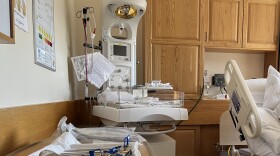An analyst hired by the state to study trends in its insurance markets told lawmakers on Wednesday that people who receive subsidies to help pay for coverage on the individual market are likely to pay about the same — maybe even less — for coverage next year, on average. But people who don’t receive subsidies could see an average increase of 52 percent.
Bela Gorman of Gorman Actuarial, said these increased rates could have wider implications for the state’s insurance markets.
“So by year end 2018, we think the individual market could lose between 5,300 to 13,000 members — due to these premium increases and other market disruptions,” Gorman said.
She was speaking on the issue at a meeting of the commission to evaluate the future of the state’s premium assistance program, otherwise known as New Hampshire's Medicaid expansion. (Gorman’s full presentation can be viewed here.)
“Because of these premium increases, the unsubsidized individuals, people who don’t receive any subsidies, will most likely exit the market,” Gorman told the group. “And those folks that are experiencing little rate change or probably negative, will probably stay in the market.”
Gorman said premium increases are one of just several factors likely to drive people away from the state’s individual market — others include the loss of Minuteman and diminished plan offerings from other carriers, as well as lax enforcement of the individual mandate requiring people to buy health insurance. As healthier people leave the market, she added, could also lead to higher average costs because there will be less room to absorb the costs of sicker patients.
The panel studying Medicaid expansion still has several months before it has to make any kind of official recommendation on the future of the program, but it’s spending lots of time studying broader market trends — including projected rate increases on the market as a whole in 2018 — as part of its work.
The projected rate increases matter to the future of Medicaid expansion because, the way the state’s program is set up, people receive help paying for coverage offered through the individual insurance exchanges.
In turn, lawmakers trying to figure out what might happen to the program after its current end date at the end of next year are zeroing in on how to insulate insurers and other patients from high costs associated with the program.
Another area of focus for the panel is how to address the issue of patients enrolling expanded Medicaid coverage and then leaving the program months later.
For about the last year, the number of people enrolled in Medicaid expansion at any given time has hovered around 50,000 to 51,000. But since it launched in August 2015, state officials say more than 125,000 people have circled through coverage.
That churn — what’s driving it, and what steps the state needs to take to make sure it doesn’t drive up costs long-term — was a key area of focus at a Wednesday meeting on the future of the program.
Senate Majority Leader Jeb Bradley, the chairman of the panel and a proponent of continuing Medicaid expansion, asked leaders from the state’s health and insurance departments to prepare an initial outline of what the structure of coverage could look like moving forward, taking into account some of the concerns heard thus far.
The commission meets weekly on Wednesdays at the Statehouse. It is supposed to file a final report on the future of the program by Dec. 1.







